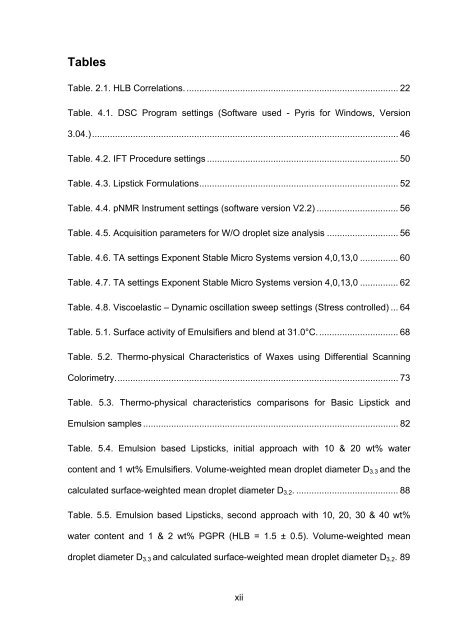Stabilisation of water-in-oil emulsions to improve - eTheses ...
Stabilisation of water-in-oil emulsions to improve - eTheses ...
Stabilisation of water-in-oil emulsions to improve - eTheses ...
You also want an ePaper? Increase the reach of your titles
YUMPU automatically turns print PDFs into web optimized ePapers that Google loves.
Tables<br />
Table. 2.1. HLB Correlations. ................................................................................... 22<br />
Table. 4.1. DSC Program sett<strong>in</strong>gs (S<strong>of</strong>tware used - Pyris for W<strong>in</strong>dows, Version<br />
3.04.) ........................................................................................................................ 46<br />
Table. 4.2. IFT Procedure sett<strong>in</strong>gs ........................................................................... 50<br />
Table. 4.3. Lipstick Formulations .............................................................................. 52<br />
Table. 4.4. pNMR Instrument sett<strong>in</strong>gs (s<strong>of</strong>tware version V2.2) ................................ 56<br />
Table. 4.5. Acquisition parameters for W/O droplet size analysis ............................ 56<br />
Table. 4.6. TA sett<strong>in</strong>gs Exponent Stable Micro Systems version 4,0,13,0 ............... 60<br />
Table. 4.7. TA sett<strong>in</strong>gs Exponent Stable Micro Systems version 4,0,13,0 ............... 62<br />
Table. 4.8. Viscoelastic – Dynamic oscillation sweep sett<strong>in</strong>gs (Stress controlled) ... 64<br />
Table. 5.1. Surface activity <strong>of</strong> Emulsifiers and blend at 31.0°C. ............................... 68<br />
Table. 5.2. Thermo-physical Characteristics <strong>of</strong> Waxes us<strong>in</strong>g Differential Scann<strong>in</strong>g<br />
Colorimetry. .............................................................................................................. 73<br />
Table. 5.3. Thermo-physical characteristics comparisons for Basic Lipstick and<br />
Emulsion samples .................................................................................................... 82<br />
Table. 5.4. Emulsion based Lipsticks, <strong>in</strong>itial approach with 10 & 20 wt% <strong>water</strong><br />
content and 1 wt% Emulsifiers. Volume-weighted mean droplet diameter D3.3 and the<br />
calculated surface-weighted mean droplet diameter D3.2. ........................................ 88<br />
Table. 5.5. Emulsion based Lipsticks, second approach with 10, 20, 30 & 40 wt%<br />
<strong>water</strong> content and 1 & 2 wt% PGPR (HLB = 1.5 ± 0.5). Volume-weighted mean<br />
droplet diameter D3.3 and calculated surface-weighted mean droplet diameter D3.2. 89<br />
xii
















